|
Rough-Floated Finish
Rough concrete provides good traction, so it is particularly suited for pool decks and other areas frequently exposed to water. It is also more durable than smooth concrete. Work the concrete with a wooden hand float; if the surface is very large, use a darby or bull float. Move the float in various patterns until the desired effect is achieved. Smooth Finish A smooth finish is practical, easy to clean and ideal for making decorative inscriptions and impressions. Use a steel trowel, moving it in sweeping arcs; overlap the arcs to make sure the entire slab is smooth.
For very smooth surfaces, additional trowelings are necessary. On the second troweling, hold the leading edge up slightly and press down a bit harder. Repeat the process used in the first troweling. The third troweling should produce an almost glossy finish. Hold the leading edge up further, press down harder, and repeat the troweling process.
|
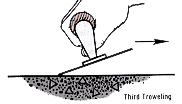
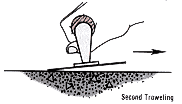
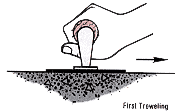
|
|
Broomed Finishes
Brooming can achieve a wide range of effects, depending on how soon you apply to broom, whether the bristles are soft or hard, and whether you sue it wet or dry. Simply pull the boom across the concrete while it is still soft. Be sure to rinse the bristles frequently to keep the tips clean.
|
 |
A damp, stiff-bristled broom produces a course texture, which is ideal for slopes and heavy traffic areas. Medium to fine textures are created with a dry, soft-bristled broom. Always pull the broom toward you in parallel, slightly overlapping strokes; never push it back and forth. Sidewalks and driveways should be broomed at right angles to the direction of traffic. Use the broom to create curves, waves, even herringbone patterns.
|
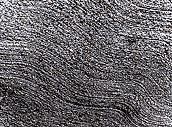 |
|
Grooved and Stamped Finishes
Grooved and stamped finishes are produced by pressing masonry stamping tools and other objects into slightly stiff concrete. Stamping tools available at most large rental centers can be used to imprint simulated paving brick, stone, tile and other patterns. Small coarse aggregate such as pea gravel should be placed in the concrete prior to the stamping. After the surface has been floated and troweled, simply step on the pad to stamp the design to a depth of about 1".
|
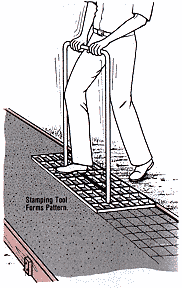 |
A piece of bent pipe works particularly well for making deep, clean grooves and a jointer can be used to groove the concrete to look like flagstone. Scoring must be done when the concrete has partially set. For a unique finish, create your own homemade stamp using typical household items such as cookie cutters.
|
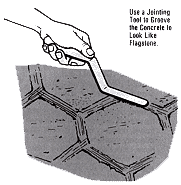 |
|
Splattered Finish
Splattered finishes are undeniably beautiful and unusual, but they are also less durable than other finishes and are most often used on walks.
|

|
They are not recommended in cold climates because of the likelihood of standing water in the depressions freezing and cracking the finish. The most common splattered finish is the travertine effect; this is achieved by first applying QUIKRETE® Concrete Bonding Adhesive to the concrete. When it becomes tacky, splatter a ½" layer of QUIKRETE® Sand Mix onto the surface with a large brush and trowel very lightly over the high spots.
|
|
A similar effect can be achieved by pressing QUIKRETE® Rock Salt into the surface of freshly floated or troweled concrete. Leave the tops of the salt grains exposed so that they can be removed by washing and light scrubbing after the concrete has cured. The result is a randomly pitted surface.
|
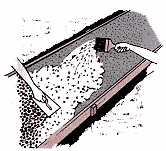 |
| Rubbed and Hammered Aggregate Finishes |
|
A powdery, dusty effect can be produced by applying a thin layer of QUIKRETE® All-Purpose Sand or Play Sand® onto a concrete surface that has partially set. Shake the sand over the entire surface, then rub it in using a piece of clean burlap.
|
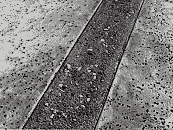 |
Medium-sized aggregate (including pebbles, small gravel, and seashell fragments) can be hammered into fresh concrete. Use a screed to evenly distribute the force of each blow.
|
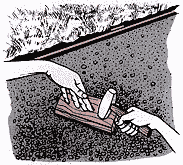 |
Exposed-Stone and Coarse-Aggregate Finishes
Stones of various shapes and sizes can be individually hand-set or sown like seeds into a surface of slightly stiff concrete. Coarse aggregate, such as large gravel, may be applied in the same way. Be sure to use clean, damp stones; after the application, press them into the mix (or slightly under the surface) with a heavy screed. Next, use a stiff-bristled broom to remove any excess mortar. Finally, clean the surface with a fine spray of water until there is not noticeable cement fill left on the aggregate. Larger cobblestone and rive stone can also be set in the surface of concrete slabs and step treads. This technique is very similar to settling pavers in a mortar bed. The fresh concrete must not be allowed to set up too stiffly before placing the stone. Press the stones into the concrete so that more than half of each one is embedded. Cover the stones with a piece of wood to protect them from being damaged if you find it necessary to hammer them into place. Brush between stones with a small hand broom for clean, even joints.
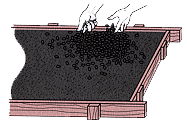 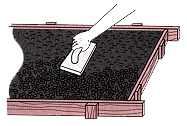
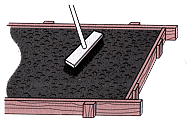 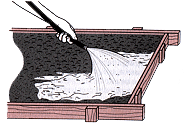
Colored Finishes
One method of coloring concrete is to pre-mix QUIKRETE® liquid Cement color with water before adding it to the dry concrete mix. This method ensures uniform color within a single batch. When coloring concrete in several batches, the proportions must be carefully controlled to achieve uniform results.
A second coloring method involves spreading dry coloring material over the concrete after it has been leveled and floated. Apply about two-thirds of the total amount of coloring material in a first application, finish as you would normally, then repeat the procedure with the remaining material.
A third coloring method has the paint, colored coating, or pigmented stain applied to the concrete after it has cured. The easiest way to apply paint to concrete or masonry is with a long nap (3/4" to 1") roller. As for staining, the concrete or mortar must be at least 60 days old prior to the application. Stains can be applied with a brush, roller, or airless sprayer.
Curing & Sealing
No matter what type of concrete finish is chosen, for best results use QUIKRETE® Acrylic Concrete Cure & Seal as the final step in achieving a durable and sealed surface.
|
